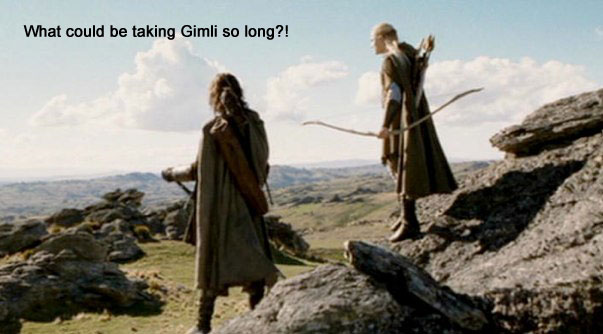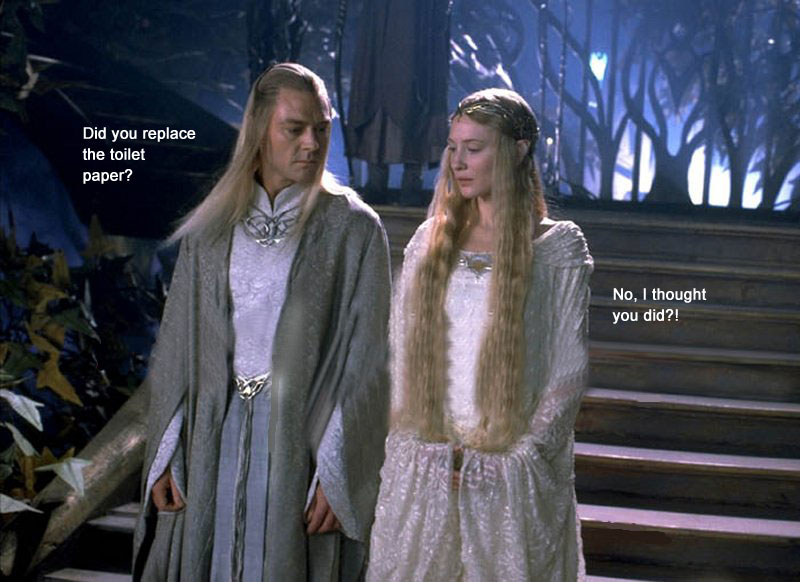 There’s a passage near the beginning of “The Fellowship of the Ring” (the book, not the movie) that, on the surface, seems peculiarly innocuous – so innocuous that I’m not sure why J.R.R. Tolkien bothered to include it.
There’s a passage near the beginning of “The Fellowship of the Ring” (the book, not the movie) that, on the surface, seems peculiarly innocuous – so innocuous that I’m not sure why J.R.R. Tolkien bothered to include it.
Frodo, Sam and Pippin had just woken up after the first night of their journey, the journey that would take the Ring from Bag End all the way to Mordor. Still in the Shire, they had slept under a tree. After Frodo got up, he…
“…stripped the blankets from Pippin and rolled him over, and then walked off to the edge of the wood. Away eastward the sun was rising red out of the mists that lay thick on the world. Touched with gold and red the autumn trees seemed to be sailing rootless in a shadowy sea. A little below him to the left the road ran down steeply into a hollow and disappeared.
When he returned Sam and Pippin had got a good fire going. ‘Water!’ shouted Pippin. ‘Where’s the water?’
‘I don’t keep water in my pockets,’ said Frodo.
‘We thought you had gone to find some,’ said Pippin, busy setting out the food, and cups. ‘You had better go now.’”
I’ve never really understood the significance of that scene. Frodo wakes up, walks off, observes the sun, the trees and the road and walks back to the campsite. When questioned, he doesn’t explain his actions – but we know he wasn’t getting water.
So what, exactly, was he doing?
A few possibilities come to mind, though none seem definitive.
Perhaps Frodo was scouting the road for enemies?
Not likely. As far as the hobbits knew at that time, they had nothing to worry about: “even Frodo feared no danger yet, for they were still in the heart of the Shire.”
OK. So maybe Frodo was just admiring the view?
That’s possible, but what’s the narrative function of Frodo admiring the view? What does that tell us, the readers? Was the author giving us the lay of the land?
Maybe. There’s a load of geographical description in “The Lord of the Rings.”
There’s another possibility, however, one that strikes me when I attempt to read between the lines of that passage. It’s an interpretation based on my own camping experiences. Why, first thing in the morning, would I walk away from the campsite without a word of explanation?
In the thousand-plus pages of “The Lord of the Rings,” in the midst of all the walking, running, riding, boating and sleeping out of doors done by the characters, never once, as far as I can tell, does Tolkien deal directly with that inescapable fact of biology: Human beings (and presumably hobbits, Elves and Dwarves) urinate and defecate.
In fact, in all of Tolkien’s voluminous writings about his invented world, the only specific mention of the topic I can find is at the beginning of “The Hobbit”, when he lists “bathrooms” among the rooms in Bilbo’s home.
In “The Lord of the Rings”, the closest we get to a character “using the bathroom”, so to speak, is the passage above, when Frodo walks off for no apparent reason. And even that, I admit, requires a leap of the imagination.
Let’s look for clues in another passage, this one from “The Two Towers”. Aragorn, Legolas and Gimli, the Three Hunters, are running through Rohan, chasing the Orcs that had captured Merry and Pippin.
“As nightshade was closing about them Aragorn halted. Only twice in the day’s march had they rested for a brief while, and twelve leagues now lay between them and the eastern wall where they had stood at dawn … He cast himself on the ground and fell at once into sleep … Before dawn was in the sky he woke and rose. Gimli was still deep in slumber, but Legolas was standing, gazing northwards into the darkness, thoughtful and silent as a young tree in a windless night … So the third day of their pursuit began. During all its long hours of cloud and fitful sun they hardly paused, now striding, now running, as if no weariness could quench the fire that burned them … At dusk they halted again. Now twice twelve leagues they had passed over the plains of Rohan and the wall of the Emyn Muil was lost in the shadows of the East … As before Legolas was first afoot, if indeed he had ever slept … The others sprang up, and almost at once they set off again.”
According to Karen Wynn Fonstad’s “The Atlas of Middle-earth,” the trio averaged 36 miles a day for three straight days – on foot. No wonder Eomer named Aragorn “Wingfoot.”

Even more impressive? They didn’t relieve themselves once.
Now, I could argue that when the Three Hunters “rested for a brief while”, it was implied that they took a pee break – but what I really need to do is address the question you’re probably asking yourself (if you’re still bothering to read this) right about now: Who cares?
Good point. Why do we need to know about the bathroom habits of Middle-earth? Can’t we just (quietly) assume the characters go whenever they get the chance? Discussing such a topic is unnecessary, not to mention gross.
I certainly won’t deny that it’s gross. But unnecessary?
Tolkien understood why his readers might be curious about even the most mundane details of his invented world: “It is, I suppose, a tribute to the curious effect that (a) story has, when based on very elaborate and detailed workings of geography, chronology, and language, that so many should clamour for sheer ‘information’, or ‘lore’,” he wrote in 1955.
I’m not sure if any of his readers asked him how hobbit bathrooms worked, or what the Elves used for toilet paper, but are those inquiries less legitimate than questions about Gondor’s economy or Sindarin nomenclature? Lore is lore, right?
Another thing: Tolkien went to great pains to portray the many discomforts of travel in a pre-technological age. His characters typically journeyed by foot, pony, horse or boat (or, occasionally, giant eagle). They were often hungry, thirsty and exhausted. He didn’t shy away from describing those miseries – but he did shy away from describing one particular misery.
So, why was Tolkien so silent on the matter? Given the dearth of information in his writings, there’s no easy way to find a satisfactory answer, but I can think of a possibility: Prudishness. This trait of Tolkien’s was perhaps best illustrated by his biographer, Humphrey Carpenter, when commenting on the following passage from Tolkien’s “The Fall of Arthur”:
“His bed was barren; there black phantoms
Of desire unsated and savage fury
In his brain had brooded till bleak morning”
According to Carpenter, that passage is “one of the few pieces of writing in which Tolkien deals explicitly with sexual passion, describing Mordred’s unsated lust for Guinever.”
“Sexual passion” is a major part of the human experience, and in all his published writings, Tolkien barely touches on it. Of the (relatively few) romantic relationships in “The Lord of the Rings,” that of Aragorn and Arwen is barely referred to (unless you’re willing to wade through the appendices), and that of Faramir and Eowyn so courtly and dignified that any talk of sex would seem completely inappropriate. But we know people procreate in Tolkien’s imaginary world. Sam Gamgee and his wife Rose, for example, have lots of kids.
(Some of you might be thinking of the episode of incest in “The Children of Hurin” and wondering: How can somebody who wrote about that be considered a prude? Well, Tolkien makes it quite clear that the incest was a mistake and an abomination brought about by an evil curse. And it’s not like he described the sex.)
Whatever his reasons, Tolkien clearly decided that certain matters – like sex, urination and defecation – were best left to the imagination. Ultimately, I’m in no position to argue with him. It was his world, not mine. I’m just grateful he shared it with the rest of us.
 But I can’t help thinking about the bathroom situation for the Elves of Lorien, which must have been tricky. Many of them lived on wooden platforms – the Elves called them flets, or talans – in the boughs of trees. Probably the biggest platform belonged to Celeborn and Galadriel, the Lord and Lady of Lorien.
But I can’t help thinking about the bathroom situation for the Elves of Lorien, which must have been tricky. Many of them lived on wooden platforms – the Elves called them flets, or talans – in the boughs of trees. Probably the biggest platform belonged to Celeborn and Galadriel, the Lord and Lady of Lorien.
“Upon the south side of the lawn there stood the mightiest of all the trees; its great smooth bole gleamed like grey silk, and up it towered, until its first branches, far above, opened their huge limbs under shadowy clouds of leaves. Beside it a broad white ladder stood, and at its foot three Elves were seated,” according to “The Fellowship of the Ring.”
“As he climbed slowly up Frodo passed many flets: some on one side, some on another, and some set about the bole of the tree, so that the ladder passed through them. At a great height above the ground he came to a wide talan, like the deck of a great ship. On it was built a house, so large that almost it would have served for a hall of Men upon the earth.”
That’s a fantastic image, but (to me) it begs the question: Where, exactly, were the privies in that house up in a tree? How did they work?
It’s possible the Elves did their business on the ground, but that seems like an awful lot of climbing. Maybe they cut a hole in the floor of the flet and let it drop?
That doesn’t seem very Elf-like. You never know if Lord Celeborn is taking a stroll at the bottom of the tree.
Yet the waste had to be taken care of, somehow. I’m afraid all we’re left with is the image of some poor Elf hauling chamber pots down that long white ladder.
But at least the chamber pots were well-made, right? There’s no reason to think the Elves of Lorien weren’t as skilled in the area of privy paraphernalia as they were in everything else they did. Indeed, judging by the quality of their rope (slender but “strong, silken to the touch”), their boats (“light-built … crafty … will not sink, lade them as you will”) and their cloaks (“light to wear, and warm enough or cool enough at need … a great aid in keeping out of the sight of unfriendly eyes”), Elven toilet paper must have been marvelous.
===================
Maedhros is a guest writer and his views do not necessarily reflect those of TheOneRing.net. Maedhros lives in Grand Rapids, MI. He’s been hooked on Tolkien since he was 11, when he opened the first page of “The Two Towers” and read about Aragorn tracking a hobbit; and Boromir’s death scene, of course.



